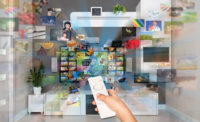Feeling overwhelmed? Of course you are. We all are, to some extent. We’re on a ride that’s getting ever faster, a ride powered by the “Law of Accelerating Returns.”
That premise, famously posited by Google Futurist Ray Kurzweil, states that information technology is growing — and learning — exponentially. Humans don’t operate that way; we are, by our nature, linear. But the machines we’ve created have the ability to double their “thinking” power at a startling rate.
As people, we plod along. We proceed in simple steps, one after another. As Kurzweil told the Financial Times: “30 steps linearly gets you to 30: one, two, three, four; step 30 you’re at 30. With exponential growth, it’s one, two, four, eight. Step 30, you’re at a billion.”
What does this mean the technology integrator? Everything.
How soon will the LANs you’re installing today become obsolete? When will copper wire disappear? When will home appliances learn to repair themselves? (Short answer to all three questions: Perhaps sooner than we think.)
And as a home tech pro, your perception of this rapid change is key: Do you look upon all of this as a threat — or an opportunity?
Dave Pedigo, CEDIA’s senior director of emerging technologies, and 16 volunteers have created the CEDIA Technology Council, a group that discusses these very things and attempts to make concrete predictions regarding what’s next in the smart home industry. Their most recent project was creating a list of 100 predictions for the year 2020 — a list that includes everything from the birth of the residential “social robot” to the end of copper wire.
In order to wrap our collective skulls around these emerging concepts and the products they’ll spawn, we’ll break them down a bit in this article.
Pedigo admitted some of these guesses could easily be wrong. According to a quote widely attributed to Bill Gates, when it comes to imagining what’s next, humans tend to overestimate what’s possible in the next two years — and wildly underestimate what’s coming in the next 10.
Here are the first 5 predictions, in no particular order.
Prediction 1: Mixed reality rooms will begin to replace home theater. You’re probably familiar with virtual reality headsets that envelop the eyes and provide a view that’s closed off. There’s also “augmented reality” technology that overlays some kind of digital information over your real-life experience. Combine those two concepts and you get a buzz-term called “mixed reality.”
As Eric Johnson summed up last year in technology news website Recode, “To borrow an example from Microsoft’s presentation at the gaming trade show E3, you might be looking at an ordinary table, but see an interactive virtual world from the video game Minecraft sitting on top of it. As you walk around, the virtual landscape holds its position, and when you lean in close, it gets closer in the way a real object would.” Can a holographic cinema experience with 3D sound and smell-o-vision really be that far off?
Prediction 2: We’ll see media with high-resolution video glasses. The hi-res tech that’s getting ever more complex on your home screens will be quite wearable in the near future.
Prediction 3: The intelligent kitchen will ensure you never burn another burger. Robotic arms will stir your sauce. Your countertops will become touchscreens. Sensors will shut off burners the moment internal meat temps hit the desired doneness. The possibilities are endless.
Prediction 4: 16K 16-bit high-framerate content is emerging. We could dive seriously into some high-tech weeds here, but Pedigo gave us this hyper-concrete example: The number of shades of red, blue and green you can see now on a state-of-the art screen is in the hundreds. Shortly it’ll be in the tens (then hundreds) of thousands.
Prediction 5: Copper wire is coming to the end of its useful application. Soon there will simply be too much data coming down the line for that metal conduit to handle. If your fortunes were made from copper mining, it might be a good time to invest in fiber-optics.
The CEDIA Technology Council has pulled together 100 predictions; follow along as we discuss the others at cedia.net/blog. See you in the future.
‘Can a holographic cinema experience with 3D sound and smell-o-vision really be that far off?’






